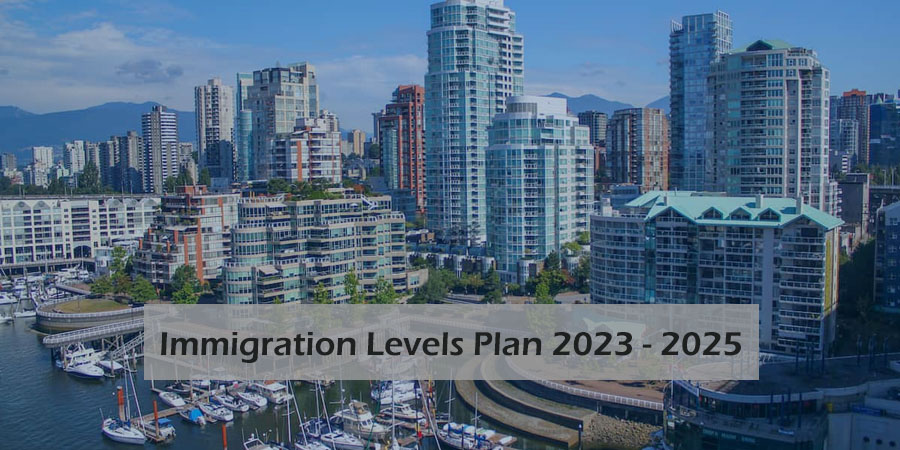– Canada recently unveiled its Immigration Levels Plan for the years 2023–2025.
– In 2023, Canada plans to take in 465,000 additional immigrants.
– In 2024, the goal will increase to 485,000 new immigrants.
– By 2025, there will be 500,000 more immigrants.
With a severe labour deficit, Canada has drastically increased the number of immigrants entering the country. The nation stated its intention to accept 465,000 new immigrants in 2023 in its Immigration Levels Plan 2023–2025.
In the years that follow, Canada will raise its immigration goal to 485,000 new immigrants in 2024 and 500,000 new immigrants in 2025.
In addition to a labour deficit, Canada is currently experiencing a rare time of roughly one million job vacancies. These are the two main causes of the country’s increasing immigration goals.
Canada has one of the lowest birth rates in the world, with 1.4 children per woman, which has a significant impact on labour shortages. One of the oldest populations in the world resides there. By 2030, nine million individuals, or over one-fourth of Canada’s population, will be of retirement age.
Justin Trudeau, the prime minister of Canada, praised the immigration strategy. “This strategy defines how we are going to increase our targets in the years ahead, and it cements our status among the top talent destinations in the world,” Trudeau wrote in a post on LinkedIn.
Trudeau continued, “Immigration helps solve workforce demands, helps businesses locate the personnel they need, and helps drive economic growth.”
The nation welcomed over 405,000 immigrants in 2021 alone, breaking its previous immigration record, and is anticipating accepting almost 432,000 immigrants this year.
Canada now anticipates an increase in Express Entry and Provincial Nomination Programs due to the present increase in the aim of immigrants’ entry (PNPs).
The bulk of new permanent residents enter the country via PNPs or economic class programmes like those found in the Express Entry system.
Table of Contents
According to CIC News, the number of principle candidates, spouses, and dependents who land under Express Entry will increase in the following ways:
82,880 in 2023
109,020 in 2024
114,000 in 2025
Additionally, the PNP will rise to:
105,500 in 2023.
110,000 in 2024
117,500 in 2025
Higher PGP admissions
The goal of IRCC is to reunite families. The Immigration Levels Plan’s second-largest permanent residence class after economic class programmes is family class sponsorship. Programs for family-based immigration require sponsors to be a spouse, partner, kid, or other immediate family member.
Under the Spouses, Partners, and Children programme, Canada will continue to seek to accept about 80,000 new immigrants each year.
The Parents and Grandparents Program’s target population will increase to 28,500 in 2023, 34,000 in 2024, and 36,000 in 2025.
Canada’s immigration strategy
In the 1980s, Canada’s present immigration policy started to take shape. The government at the time did not plan as far ahead and frequently based immigration targets on the current state of the economy.
Canada received fewer than 90,000 immigrants in 1984. The Canadian government, led by the Conservatives, anticipated a labour shortage in the early 1990s and upped immigration targets to 250,000 new permanent residents in just eight years.
The succeeding Liberal administration expanded on these goals but, as a result of a financial crisis, started to emphasise welcoming more immigrants from the economic class and lowering Canada’s proportion of immigrants from the family and humanitarian classes.
Up to the current Liberal administration entered office in 2015, Canada admitted about 260,000 immigrants yearly. Prior to the COVID-19 pandemic starting in 2020, the targets were raised to 300,000 and then 340,000.
In 2020, it was challenging for the IRCC to process applications due to border closures and other travel restrictions. Nevertheless, Canada exceeded its goal for immigration in 2021 and admitted 405,000 more permanent residents than ever before. These goals were met thanks to the Canadian Experience Class and Provincial Nomination Programs’ generous slot allocations (PNPs).
Canada Express Entry Score:
The minimum Comprehensive Ranking System score recently fell below 500 for the first time since December 2020 in Canada’s Express Entry draw. This time, 4,750 applicants with a minimum Comprehensive Ranking System (CRS) score of 496 received invitations. The CRS has fallen below 500 for the first time since the draws commenced. On December 23, 2020, a score of 468 was recorded, which was the previous time the score was this low.
Read Here: BC PNP Latest Draw 2022
Immigration, Refugees and Citizenship Canada (IRCC) will be able to grant more ITAs for Canadian permanent residents by decreasing the CRS score.

